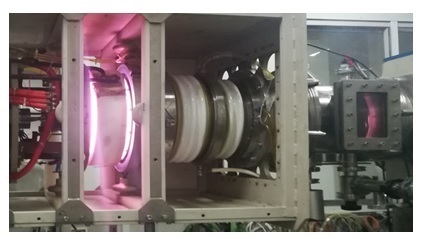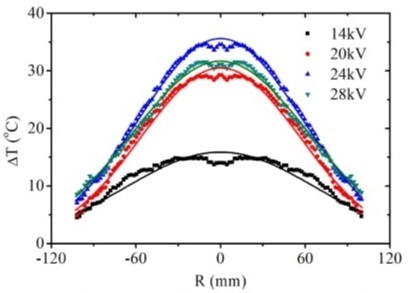Speaker
Description
Development of megawatt radiofrequency ion source for the neutral beam injector on HL-2A tokamak
L.W. Yan, G.J. Lei, M. Li, X.M. Zhang, M. Zhao, Y.N. Bu, W.M. Xie, Y.X. Zhang, G.Q. Zou, H.L. Wei, L.P. Huang, S.F. Geng, X.Z, Ma, Q. Yu, J.Y. Cao, Bo Lu, Z.B. Shi, C.P. Zhou, M. Xu and X.R. Duan
Southwestern Institute of Physics (SWIP), Chengdu, Sichuan 610225, China
E-mail: lwyan@swip.ac.cn
Neutral beam injection (NBI) is rather significant for plasma heating, current drive, fueling and profile control in large tokamaks, whose key component is the ion source. The construction of NBI system on ITER still meets some challenges. Its typical parameters are 16.5 MW/ 1 MV/ 3600 s. The radiofrequency (RF) negative ion source is a suitable choice for ITER NBI $[1]$.
Recently, an RF ion source with megawatt power extraction has been developed for the neutral beam injector on HL-2A tokamak at SWIP. A full solid-state RF generator with output power of 80 kW and frequency of 2 MHz is built by an RF combiner using 8 modules of solid-state RF generator of $P_{RF}$ = 10 kW. The line electric efficiency of whole RF generator reaches 92% and its voltage standing wave ratio (VSWR) is 1.01 after using fully automatic match technique. A quartz vessel with the inner diameter of 250 mm is directly adopted for resisting atmospheric pressure, which can dramatically simplify ion source structure, as shown in figure 1.

Nowadays, the extraction parameters of RF hydrogen ion beam are 32 kV/20 A/0.1 s on a test bed using the power of $P_{RF}$ = 26 kW, as shown in figure 2, while its design parameters are 50 kV/20 A/3 s. The discharge duration is limited by the power supply of capacitor bank. The half width of 1/e power decay is 83 mm at 1.3 m downstream from the accelerator using infrared imaging diagnostics at 3.4 m downstream, which obeys Gaussian distribution, see figure 3. The beam divergence angle is smaller than $1^o$. The extractable current density increases almost linearly with the RF power. It reaches 0.24 A$\cdot$cm$^{-2}$ at $P_{RF}$ = 32 kW. The ion density in front of plasma grid is about $1.2\times 10^{18}$ m$^{-3}$ at gas pressure of 0.5 Pa. The hydrogen ion fraction of extraction beam increases with the accelerator current, which reaches 79 % at $I_{acc}$ = 12.4 A. Plasma homogeneity is over 90% at low RF power.
The RF plasma source of innovative high-pressure density gradient solves its initial ignition problem, providing an important startup scheme for RF negative ion sources and a good method for generating thermal atoms. The relevant components include two sets of RF systems (40 kW/2 MHz and 3.5 kW/13.56 MHz), main and auxiliary discharge chambers, plasma diagnosis, vacuum system and so on. The initial plasma excitation, main plasma discharge, plasma diffusion, RF attenuation along axis are investigated. Using this system, gas density measurement and control are completed. The plasma density profiles in the two discharge chambers and diffusion section are simulated to optimize their gas densities.
The total RF power of 80 kW is going to use in the next experimental campaign. The beam characteristics will be carefully investigated by using Faraday cups and thermocouples, whose results may be compared with the infrared imaging diagnostics for providing more plentiful information of ion source profiles. The extraction capability will be enhanced by improving vacuum condition, using stronger power supply such as motor generator and so on. In addition, the RF negative ion source of 200 kV/20 A/3600 s is also developed at SWIP for the CFETR (China Fusion Engineering Test Reactor), and the accelerator voltage will be extended to 500 kV in future.
In summary, a megawatt RF ion source has been developed with quartz chamber and an innovative method of high-pressure density gradient produced by two sets of RF systems solves its initial ignition problem. The line electric efficiency of whole RF generator reaches 92% after using fully solid-state RF generator and automatic match technique. The extracted ion beam presents Gaussian distribution according to infrared imaging. The RF negative ion source of 200 kV/20 A/3600 s is also developed at SWIP for the CFETR.
This work is partially supported by Natural Science Foundation of China with Grant Nos. 11875020 and 11320101005, and by National Key R&D Program of China under Grant No. 2017YFE0300100.


1 U. Fantz, C. Hopf, D. Wünderlich, et al. Nucl. Fusion 57, 116007 (2017).
| Affiliation | Southwesten Institute of Physics |
|---|---|
| Country or International Organization | China |
